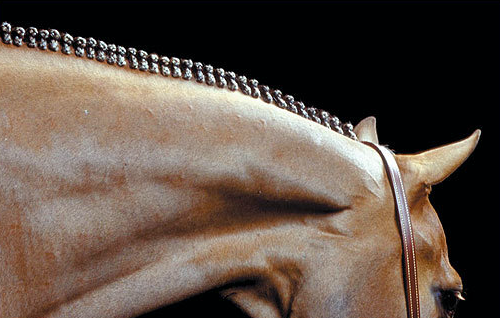How to Braid a Mane
As with most things in the equestrian world, the braiding of a horse’s mane and the tail is a tradition and makes a huge statement in the show ring. While braiding customs may come from the days of cavalry drills and foxhunts, today braids are most often seen in the show ring. Depending on the discipline, different styles can be seen and is a great way to show off a horse’s top line.
Hunter (or flat) Braids

image from www.luckybraids.com
These braids are a must at any A-rated show. Hunter braids use yarn that closely matches the color of the mane for understated elegance. A throwback to tradition when an unbraided mane could get tangled out on a foxhunt, today’s hunter most commonly has a pulled mane to make this time-consuming braid a bit easier. Once finished, the neckline is clearly shown with an elegant presentation. By far the best how to for hunter braids is Lucky Braids by Ruthann (photo from Lucky Braids above www.luckybraids.com). Hunter braids Video
Button (or Rosette) Braids

image from: http://animals.mom.me/button-braids-horses-mane-dressage-3665.html
These are a popular choice for the dressage ring. Button braids are a durable and forgiving braid. Button braids are traditionally done with needle and thread but can also be done with rubber bands or yarn. Mane hair that is five inches or so is the ideal length. A longer mane will make rounder “buttons.” The hair is sectioned off (each section being about the width of your hand) and as the braid is pulled up a ball is formed as it is sewn. Button braids that number 11-17 braids down the neck are considered appropriate.
Banded Plaits
This style works well with a thinner, short mane. The mane is braided straight up and then secured with a rubber band before its folded over in the opposite direction of the way the mane falls on the neck. Tape or other banding material is then wrapped around the braid. Banded plaits can add definition to a straight neck and is a striking look when a contrasting tape is used.
Running Braid

Image from http://www.reginadistrictdressage.ca/braiding.html
This features a french braid that runs down the neck. This braid requires a fairly long mane and is more commonly seen on Lipizzans, Andalusians and Friesians and other similar breeds. How to do a running braid - full tutorial.
Continental Braid

image from http://myhorseforum.com/threads/the-continental-braid.37450/
This term is a slight misnomer as in this hairstyle the mane is actually woven rather than braided, and so the procedure can be referred to as Diamond Weave or Woven Mane as well. The arrangement works best with long manes as the completed look should extend about halfway down the neck. It involves sectioning and rubber banding the mane into equal parts near the neckline. Then each section is further divided into two parts with each half of the section being banded together with the half of the section next to it several inches below the initial banding. The dividing and banding process will result in a pattern that resembles netting.
The Continental Braid arrangement works best with long manes as the completed look should extend about halfway down the neck.
There are so many options to choose from when braiding your horse's main and today’s show horse can be seen with a variety of braids to show off the perfect topline or create the illusion of a longer neck. Next time you’re by the ring, be sure to check out the artistic work displayed!

